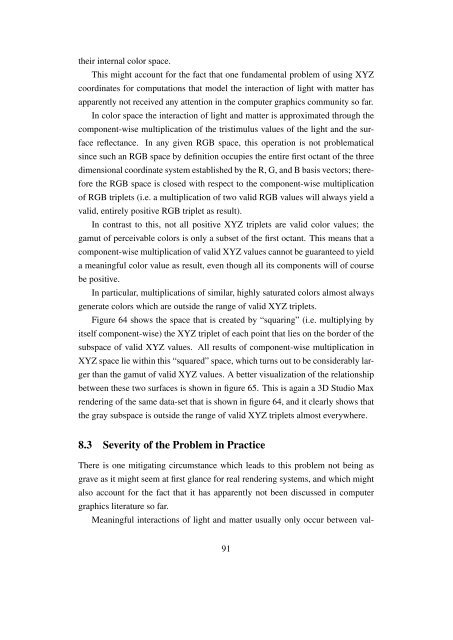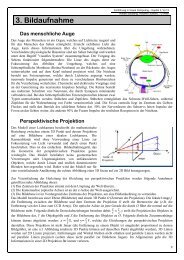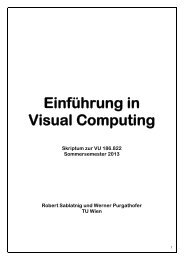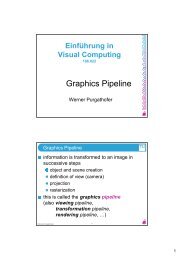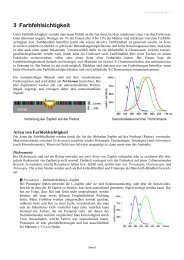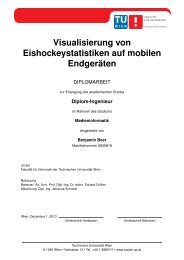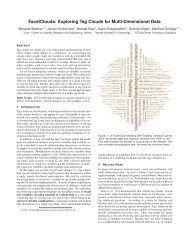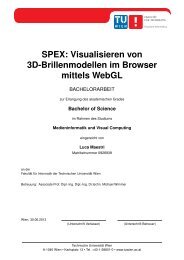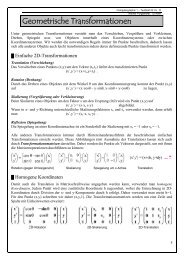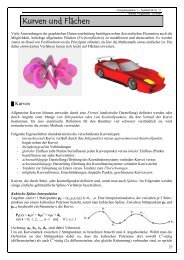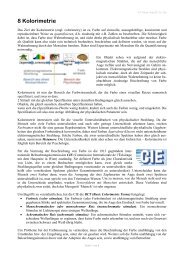Usability of Digital Cameras for Verifying Physically Based ...
Usability of Digital Cameras for Verifying Physically Based ...
Usability of Digital Cameras for Verifying Physically Based ...
You also want an ePaper? Increase the reach of your titles
YUMPU automatically turns print PDFs into web optimized ePapers that Google loves.
their internal color space.<br />
This might account <strong>for</strong> the fact that one fundamental problem <strong>of</strong> using XYZ<br />
coordinates <strong>for</strong> computations that model the interaction <strong>of</strong> light with matter has<br />
apparently not received any attention in the computer graphics community so far.<br />
In color space the interaction <strong>of</strong> light and matter is approximated through the<br />
component-wise multiplication <strong>of</strong> the tristimulus values <strong>of</strong> the light and the sur-<br />
face reflectance. In any given RGB space, this operation is not problematical<br />
since such an RGB space by definition occupies the entire first octant <strong>of</strong> the three<br />
dimensional coordinate system established by the R, G, and B basis vectors; there-<br />
<strong>for</strong>e the RGB space is closed with respect to the component-wise multiplication<br />
<strong>of</strong> RGB triplets (i.e. a multiplication <strong>of</strong> two valid RGB values will always yield a<br />
valid, entirely positive RGB triplet as result).<br />
In contrast to this, not all positive XYZ triplets are valid color values; the<br />
gamut <strong>of</strong> perceivable colors is only a subset <strong>of</strong> the first octant. This means that a<br />
component-wise multiplication <strong>of</strong> valid XYZ values cannot be guaranteed to yield<br />
a meaningful color value as result, even though all its components will <strong>of</strong> course<br />
be positive.<br />
In particular, multiplications <strong>of</strong> similar, highly saturated colors almost always<br />
generate colors which are outside the range <strong>of</strong> valid XYZ triplets.<br />
Figure 64 shows the space that is created by “squaring” (i.e. multiplying by<br />
itself component-wise) the XYZ triplet <strong>of</strong> each point that lies on the border <strong>of</strong> the<br />
subspace <strong>of</strong> valid XYZ values. All results <strong>of</strong> component-wise multiplication in<br />
XYZ space lie within this “squared” space, which turns out to be considerably lar-<br />
ger than the gamut <strong>of</strong> valid XYZ values. A better visualization <strong>of</strong> the relationship<br />
between these two surfaces is shown in figure 65. This is again a 3D Studio Max<br />
rendering <strong>of</strong> the same data-set that is shown in figure 64, and it clearly shows that<br />
the gray subspace is outside the range <strong>of</strong> valid XYZ triplets almost everywhere.<br />
8.3 Severity <strong>of</strong> the Problem in Practice<br />
There is one mitigating circumstance which leads to this problem not being as<br />
grave as it might seem at first glance <strong>for</strong> real rendering systems, and which might<br />
also account <strong>for</strong> the fact that it has apparently not been discussed in computer<br />
graphics literature so far.<br />
Meaningful interactions <strong>of</strong> light and matter usually only occur between val-<br />
91


